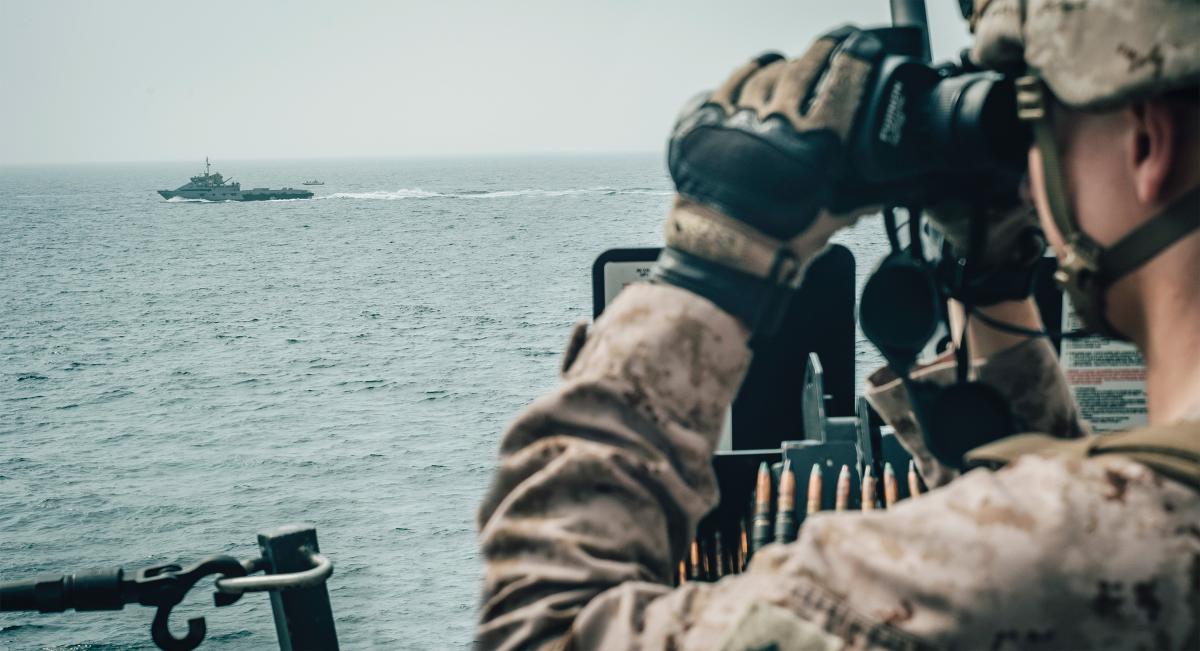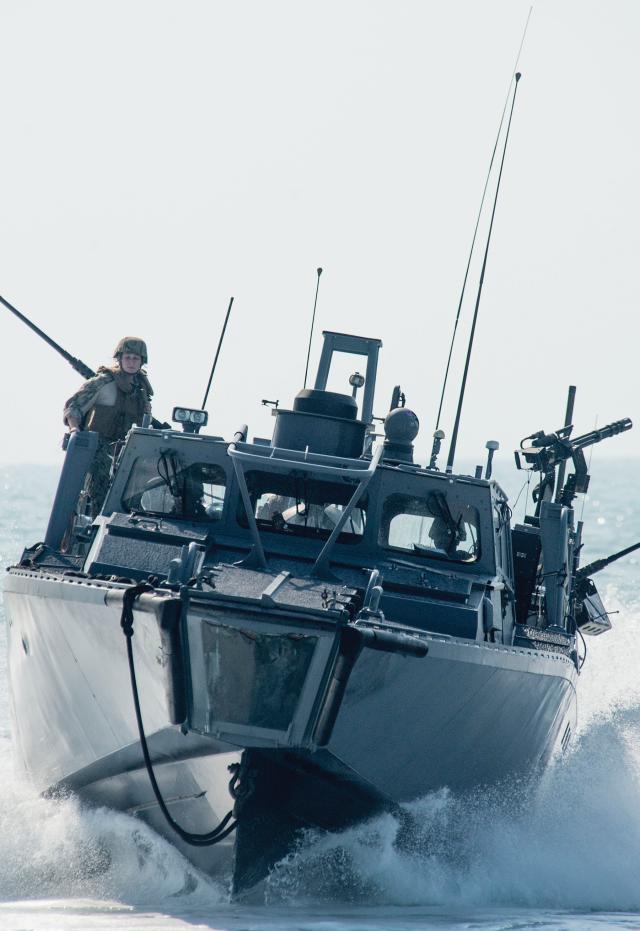When General David Berger released his Commandant’s Planning Guidance (CPG) in July 2019, it was met with a variety of reactions across the Marine Corps. The most common seemed to be excitement. Throughout the ranks, Marines recognized that the guidance could mean significant changes in nearly all areas of the force—from manning, training, and equipping to the fundamental employment of Marine forces ashore. Most tellingly, in the conclusion of the document, the Commandant directs (in bold and highlighted) that the service must be able to “facilitate sea denial in support of fleet operation and joint force horizontal escalation.”1
Although opinions differ regarding the exact requirements for a Marine force to present a credible sea-denial threat, it is certain to demand significant adjustments to capabilities currently resident in the Corps. The service has begun to dabble in sea-denial capabilities with the coming acquisition of the Naval Strike Missile, but a single missile is insufficient to deny water space to a near-peer, technologically advanced opponent.2 Indeed, advanced navies across the world design their ships to defend against the exact capability the Marine Corps is acquiring.3 Ultimately, the Naval Strike Missile is a start, but if the Corps intends to pursue sea denial as an essential task, it must reimagine force design, equipment, education, and the overall concept of employment. The most effective way to do this will be to model proven sea-denial concepts, tactics, techniques, and procedures. Indeed, the service should identify the most capable sea-denial forces worldwide, study and improve on their existing strategies, and structure its force to employ the most effective elements therein.
The Iranian Sea-denial Model
One example of a capable sea-denial force the Marine Corps could use as a baseline is the Iranian Revolutionary Guard Corps Navy (IRGCN).4 IRGCN capabilities are tailor-made for sea denial—that is the service’s primary mission. And while their effectiveness is aided by geography and the fact that the IRGCN generally enjoys a home field advantage, these capabilities nonetheless could be considered a model for a sea-denial force.
The IRGCN could be a useful example for several key reasons. First, it has designed its force with flexibility in mind. It understands that a sea-denial fight against a highly advanced opponent (in this case, the U.S. Navy) requires multiple overlapping and complementary capabilities that expose enemy vulnerabilities. In the parlance of Marine Corps doctrine, the IRGCN is a master of a flexible combined-arms approach: An adversary’s actions to counter some threats necessarily expose them to others.
Second, the IRGCN understands that when fighting a peer or superior opponent (in the U.S. case, a more technologically advanced one), asymmetric methods are likely to be more effective than direct engagement. In a similar vein, the CPG directs the development of “stand-in forces”—low signature, risk-worthy, tactically disruptive forces.
Third, because of the flexibility and irregular nature of the IRGCN, it is extremely resilient. The decentralized command-and-control model it employs is resistant to disruptions to the overall mission/kill chain—precisely what the Marine Corps espouses in its doctrine of mission command.
The IRGCN integrates multiple combined-arms capabilities that complement each other, sometimes in unusual or novel ways. Outside the IRGCN, the Iranian military maintains conventional capabilities much like the U.S. joint force. It has a separate and capable ballistic-missile force that combines with a conventional air force and navy to hold Iran’s enemies at risk beyond the sea-denial envelope.5 It also maintains special operations/gray zone capabilities throughout the region in the Quds Force. In the event of open conflict, these forces would sabotage enemy logistics, provide cuing for enemy targets, and hold targets within potential adversary nations at risk (potentially affecting their willingness to enter the conflict).
All these capabilities then combine with IRGCN forces that have the ability to threaten foreign naval assets traveling within the Arabian Gulf. In particular, the IRGCN layers long-, medium-, and short-range antiship cruise missiles (launched from sea, land, and air); fast attack craft/fast inshore attack craft (FACs/FIACs) armed with shorter range cruise missiles, rockets, heavy machine guns, and boarding parties; explosive boats (both manned and unmanned, “waterborne IEDs” and targeted versions); suicide drones; mining (with both basic and advanced mines); and static forces based on islands and gas and oil platforms throughout the areas it intends to deny.6 Separately, none of these assets would overwhelm a capable navy, but combined they create an extremely dangerous environment in the littorals of the Arabian Gulf.
The combined-arms problem the IRGCN creates is not unique; many militaries maintain similar sea-denial capabilities in varying degrees. However, its interlocking capabilities pair with an overall employment model that focuses on asymmetric action, mixing “advanced technology with guerrilla tactics.”7 The IRGCN has no intention to pursue a large-scale naval battle; instead, it employs its sea-denial capabilities in accordance with “classical irregular warfare principles historically used by revolutionary forces.” In practice, this manifests itself as “hit and run style, surprise attacks, or the amassing of large numbers of unsophisticated weapons to overwhelm the enemies’ defenses.”8 In many ways, this style of fighting aligns with the emerging design for Marine Corps sea denial described in the broad concept for expeditionary advanced base operations (EABO) and specifically identified in the CPG as one of Commandant’s priorities for future force design.9
Finally, the IRGCN prizes resiliency. It has designed its command-and-control structure to survive threats from U.S. precision targeting by using what it terms “mosaic defense.” This concept decentralizes command and control, disperses key sites, and favors hidden/hard to detect and target sea-denial capabilities such as coastal defense cruise missile sites and midget submarines. In practice, it decentralizes decision-making authority within the naval command structure and entrusts FACs/FIACs and other IRGCN sea-denial assets to attack enemy or neutral shipping while remaining under radio silence.10 The IRGCN has operationalized mission tactics in the sea-denial mission.
The Marine Corps’ warfighting philosophy lends itself to a similar concept; one could envision Marine units conducting sea-denial operations in the vicinity of high-traffic choke points while maintaining limited visual and electromagnetic signatures. However, while low-level initiative, simple orders, and commander’s intent are inherent in the Marine Corps’ warfighting philosophy, the service has yet to establish processes, procedures, or a culture that would accept the risk inherent in a doctrine analogous to the Iranian mosaic defense, particularly given the distances that would separate small Marine sea-denial elements in the Pacific, Indian, or Atlantic Ocean.
Elements to Emulate
If the Marine Corps is serious about becoming a sea-denial force, it should emulate the most effective elements of the IRGCN. First, it must acquire effective sea-denial capabilities. The Naval Strike Missile is useful, but it is insufficient. Modern near-peer warships and battle groups are designed to mitigate the threat of antiship cruise missiles (ASCMs). A sea-denial force might deal with this in two ways: either by firing large volleys of missiles to overwhelm enemy missile-defense systems, or by forcing the enemy to deal with multiple threat vectors—surface craft, undersea threats, hypersonic cruise missiles, slower suicide drones, mines, even “dumb” rockets—simultaneously.
This means the Marine Corps must move beyond acquisition of an antiship missile that can fire from a HIMARS launcher and develop sea-denial units with a broad mix of capabilities that can be employed in accordance with local conditions. The sea-denial force must have its own mid- to long-range surface vessels (perhaps analogous to the Mk VI or riverine command boats), must be able to emplace various types of mines, and should have access to multiple types of ASCMs with differing ranges and flight profiles. It also will need to be able to provide its own targeting data using surface-search radar, signals intelligence, AIS exploitation, and national technical means, as well as protect itself against long-range fires, gray zone operations, fleet engagement, and other enemy actions.
In addition, the Corps must recognize that there are elements of its sea-denial force that have no analog in other militaries—particularly the F-35B. Marine sea-denial forces will have to be able to integrate this asset to facilitate the detection, tracking, and subsequent engagement of enemy shipping at ranges not previously explored.
Second, the Marine Corps must be willing to slay some sacred cows. For example, because the sea-denial force may not be built around infantry formations, infantry may no longer be the main effort. The service must be prepared to revamp the existing manpower model, and, as it restructures, to tell the joint force that the Marine Corps no longer executes certain missions.
Third, and perhaps most important, the Marine Corps must recognize the need to decentralize authority to enable distributed sea-denial forces to engage enemy forces based on their understanding of commander’s intent—without centralized guidance or clearance. Although service doctrine espouses this type of mission tactics, the new sea-denial doctrine will require far more decentralization than previously has been acceptable.
If, as the Commandant says, a future mission of the Marine Corps is sea denial to support subsequent fleet operations, the reconfiguration of the force must be aggressive and immediate. Like the Marines of the interwar period, who assumed significant risk to the institution by developing concepts and plans for amphibious assault that were considered impossible, we must now reconfigure our force to support the operations of the greater fleet. To paraphrase former Secretary of Defense James Mattis, we must do more than just listen to other nations’ ideas; we must recognize that not all good ideas come from the country with the most aircraft carriers.11
1. Commandant of the Marine Corps, Commandant’s Planning Guidance (Headquarters Marine Corps, 2019), 23.
2. See Sam LaGrone, “Raytheon to Arm Marine Corps with Anti-Ship Missiles in $47M Deal,” USNI News, 8 May 2019, and Wayne P. Hughes and Robert P. Girrier, Fleet Tactics and Naval Operations, 3rd ed. (Annapolis, MD: Naval Institute Press, 2018), 262–93.
3. Talal Husseini, “Safeguarding the Seas: Top Naval Air Defence Systems,” Naval Technology.com, 8 May 2019; “Destroyers,” Sinodefence.com.
4. See “Need to Know,” U.S. Naval Institute Proceedings 146, no. 2 (February 2020): 10-12, for the IRGCN order of battle.
5. Sam Tangredi, Anti-Access Warfare: Countering A2/AD Strategies (Annapolis, MD: Naval Institute Press, 2013),188.
6. James Martin, “Design Characteristics of Iran’s Ballistic and Cruise Missiles,” Center for Nonproliferation Studies, 2013, https://media.nti.org/pdfs/design_characteristics_iran_missiles_3.pdf, and Mark Gunzinger with Chris Dougherty, Outside-In: Operating from Range to Defeat Iran’s Anti-Access and Area Denial Threats (Center for Strategic and Budgetary Assessments, 17 January 2012), 33–47.
7. Gunzinger and Dougherty, Outside-In, x.
8. Office of Naval Intelligence, Iranian Naval Forces: A Tale of Two Navies (Department of the Navy, 2017), 23.
9. U.S. Marine Corps, “Concepts and Programs, Expeditionary Advanced Base Operations,” www.candp.marines.mil/Concepts/Subordinate-Operating-Concepts/Expeditionary-Advanced-Base-Operations.
10. See LCDR D. M. Layton, “Iran’s Hybrid Naval Force: Flexibility Is the Key to Sea Power,” unpublished paper, Canadian Forces College, 2015, 4, 6.
11. James Mattis, “Remarks on the National Defense Strategy,” Paul H. Nitze School of Advanced International Studies, 19 January 2018, www.defense.gov/Newsroom/Transcripts/Transcript/Article/1420042/remarks-by-secretary-mattis-on-the-national-defense-strategy/.





